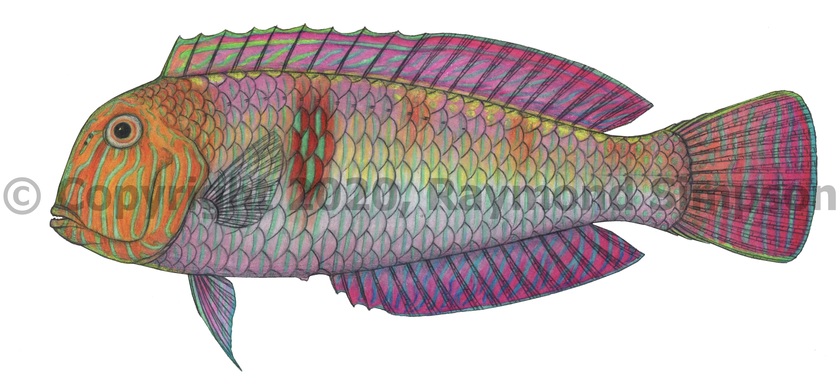
Common Name
Pearly Razorfish
Year Described
Linnaeus, 1758
Identification
Dorsal Fin: IX, 12
Anal Fin: III, 12
Pectoral Fin: 12
Lateral Line Scales: 19-22 (anterior) + 5-6 (posterior)
Gill Rakers: 18-21 total
Caudal Rays: 14 principal
Body elongate and compressed. Forehead profile very steep and almost straight. Mouth oblique and terminal. Upper jaw with a pair of enlarged canines flanked with smaller canines. Edges of preopercle and opercle smooth. Scales large and cover body. Head almost unscaled except on nape and a small patch on cheek. Fins naked except for 2-3 rows on base of caudal fin. Dorsal fin long and low with the origin well forward (almost above eye). First two dorsal spines more flexible than remaining spines (anterior dorsal fin raised in juveniles with a deep notch behind spine two). Anal fin origin under last dorsal spine. Pelvic fin not elongate. Caudal fin rounded. Lateral line in two portions: the first arched and ending under 10th dorsal ray and the second short and straight on caudal peduncle.
Color
Terminal Phase: Ground color pale yellow to whitish on the flanks and rosy to purple on the dorsum and belly. Thin vertical greenish to blue lines cover entire body following scale rows. Green and orange lines on head and cheek. An oblique dark orange to brown bar behind pectoral fin runs from back to lower trunk. Base of dorsal fin with yellow scale edges. Dorsal fin with pink to red base coloration and numerous green spots and lines. Anal fin red with oblique blue lines. Caudal fin red with green vertical lines. Pelvic fin red and green. Pectoral fin clear. Eye white with concentric red rings. Initial Phase: similar to terminal male but paler over most of body. Tends to be flesh colored or pale pink with faint or dark brown bands that can be darkened or lightened with mood. Green and orange lines apparent on cheek and reddish speckles and a pearly blotch on belly. Anal fin red and green. Juveniles: body mottled in shades of brown. Can range from heavily barred to pale with a lateral stripe and a dark blotch on the flank. Eye reddish. Front part of dorsal fin raised.
Size
Maximum size of terminal males to 250mm SL.
Habitat
Inhabits open sandy plains from 5-110m.
Range
South Carolina to the Gulf of Mexico and the Caribbean Sea to southern Brazil.
References
Nirchio, M., Gaviria, J.I., Siccha-Ramirez, Z.R., Oliveira, C., Foresti, F., Milana, V. & A.R. Rossi. 2019. Chromosomal polymorphism and molecular variability in the pearly razorfish Xyrichtys novacula (Labriformes, Labridae): Taxonomic and biogeographic implications. Genetica, 147(1), 47-56.
Randall, J.E. 1965. A review of the razorfish genus Hemipteronotus (Labridae) of the Atlantic Ocean. Copeia 1965 (4), 487-501.
Other Notes
There is growing evidence that the species known as Xyrichtys novacula is made up of multiple species. Even Randall (1965) noted differences between Brazilian specimens and Caribbean specimens but were too subtle in his opinion to diagnose separate species. Many years later, Nirchio et al. (2019) found genetic differences corresponding to three clades: one in the Caribbean, one off Brazil, and one in the eastern Atlantic. The clades are equally or more divergent than distinct eastern Pacific species were to each other. The name X. psittacus that was applied to western Atlantic populations by Linnaeus may well be valid, and the name X. uniocellatus is available for Brazilian specimens. Further taxonomic work is needed for these species to be re-validated but if the species is split X. novacula would be restricted to the eastern Atlantic. The psittacus form fish have a characteristic dark vertical bar on the flank, while the Brazilian uniocellatus form fish have a small ocellated spot between spines 6-7 and no bar.